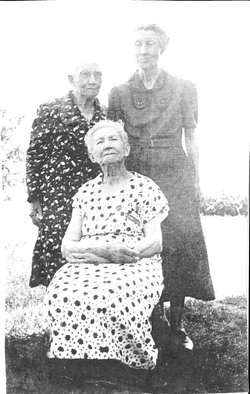Blanche carefully pulled the freshly washed sheet up over her mother. Cornelia was just a teeny wisp of an old lady now bedbound with her arthritic arms and legs contracted into a semi-fetal position. The family situated her bed on cinderblocks in the open dining room, where their lives intersected, and Blanche provided all her mother’s care.

A petite rocking chair next to the bed appealed to the grandchildren, though they had been cautioned to reserve this special seat for their great-grandmother when she felt well enough for Blanche to gently lift her out of bed for a spell.
Blanche’s daily chores on the farm kept her constantly on the go. In the mornings she gathered eggs from the hens and in the afternoon she pulled weeds in the garden, swept, dusted. Meanwhile, she fried eggs and potatoes for breakfast with toast and jam. At noon, she killed, cleaned, and fried a chicken for dinner, served with more potatoes and vegetables. At supper, there was more meal preparation from scratch and clean up. After preparing each of these meals, Blanche would grind the meat and mash the vegetables for her mother’s nourishment.
Then, there were all the chores to be completed by hand throughout the week: washing and ironing and mending and marketing and baking, and cleaning. She rarely sat down. But she loved her family and her life. She was always happy and whistling and joking around as her grown children and grandchildren would come around every week or two for Sunday dinner.
Cornelia grimaced ever so slightly when her legs were being adjusted, and Blanche caught the brief recognition of pain on her face. “Mother, I know you hurt. How come you never complain?” Blanche lovingly asked while smoothing back her hair. “You never do,” her mother responded.
This apocryphal story of my great-grandmother and my great, great-grandmother demonstrates the love of family and care for each other despite difficulties. There probably wasn’t a choice. If someone lived to be old to the point that they needed help with everyday activities, someone had to help, and it was almost always a close family member. There weren’t the residential options that we have these days.
“Mother, I know you hurt. How come you never complain?” Blanche lovingly asked while smoothing back her hair. “You never do,” her mother responded.”
The convenience of old age homes
With time, the landscape of old age care evolved such that older adults were less likely to be cared for in private family homes. The hard physical labor of the first half of the 20th century gave way to promises of an easy life. My grandmothers started their lives washing clothes with a ringer washer. By the middle of their lives, automatic washing machines were convenient and accessible. New time-saving improvements, such as packaged and prepared food, electric vacuum cleaners, and gas and electric kitchen appliances abounded. Everywhere you went, you could see families acquiring refrigerators, stoves, ovens, mixers, and even electric can openers! Ready-made clothes were widely available, and economical cars were much more reliable. The increased ease of travel lured people into working further from home and moving further from family. With the conveniences came a feeling of prosperity. Machines helped ease the work! Families could spend more time on leisure and hobbies. The seduction was heady!
During the 1960s, an explosion of nursing homes fed on this desire for a care-free life with promises of comprehensive care for older family members. When I grew up in the 1960s, I remember hearing conversations about how people were moving grandparents to a nursing home. There was a hope that nurses would attend to them around the clock with an expertise that family members did not possess.
One “nursing” home in the 1960s was in an old stately home in Kansas City that was crudely retrofitted for the elderly. The ground floor had the original parlor made into a bedroom for four elderly ladies with privacy curtains dividing the room from the hallway. A washroom on the ground floor included a toilet and a lavatory. There wasn’t a bathtub on the ground floor, but even if there was, these weak ladies couldn’t get in and out of the high clawfoot tub. Residents who could walk shuffled to the table in the dining room for meals. While the aluminum walker, as we know it, was patented in 1964, it was new at this time and not yet widely used.
Four bedrooms upstairs housed 2 residents in each room. A couple of these residents perilously climbed up and down the stairs during the day. Many of the residents were mostly bed- or chairbound and had their meals delivered to them.
The nursing home dilemma
Over time, it became apparent that the staff in nursing homes could not provide time-consuming personalized care to many people at once who had numerous self-care and supportive needs. Though the name was a “nursing” home, it soon became clear that the biggest need for the people in the home was not skilled nurses (that is, with a nursing degree) but non-skilled assistants who could help the residents bathe, groom, dress, and toilet.
If the nursing home resident had difficult behaviors associated with what we now call dementia but then was called senility or organic brain syndrome, the new antipsychotics, such as Thorazine, were easily available to calm them down. Staff were flummoxed with the confused and wandering residents who put themselves at risk for falling and eloping. So, even though the antipsychotics manifested dangerous side effects, staff only knew to tie down or medicate the difficult residents. While nursing home regulations in the 1960s addressed these concerns, it took many years for the prevailing wisdom to agree that drugging and tying down residents was wrong.
Are these nursing homes “homes” or are they medical facilities? They are a mixed bag in that Doctors’ orders state what the resident may eat, if they may leave the facility, etc. But most needs of the residents are non-skilled, that is, mobility and toileting assistance, incontinence care, bathing, dressing, grooming, as well as higher-level activities such as meal preparation and administration of medications.
Through the years, it became apparent that nursing homes, despite their names such as Hilltop Haven and Sunset Solace, were not the beautiful places of rest that they were touted to be. It wasn’t long before people started saying (for good reason), “I never want to be in a nursing home.” Thereafter, the term Nursing home fell out of favor to more euphemistic labels, such as long-term care and skilled nursing facility (even when the care is not skilled). Regulations improved some of the care but made a more rigid institutional environment. For instance, it is difficult for residents in long-term care to have regular administration of strong pain medications because of the regulatory burden of being audited and punished. As a response, “Assisted Living” facilities popped up with fewer regulations and more freedom for residents.
Loving sacrifice
The story of my great-grandmother inspires me to turn back to the past and have the honor of serving my parents. I see that facilities are never as faultless and exhaustive as the marketers try to make them out to be, and I know that essentially everyone would really prefer to stay in their own home. It was extraordinarily difficult for Blanche to add the tasks of caring for her mother to her exhausting life but she It may not work out for everyone, but I hope to be like my great-grandmother Blanche, who never complained about caring for her disabled mother. She sacrificed because she loved her.

Leave a Reply